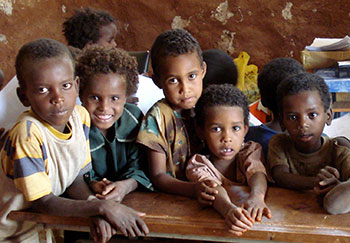To foster improvement in surveillance, PMI supported an operational research study on the use of school-based surveys to generate up-to-date data for planning malaria control interventions.

These children participated in a school-based survey of malaria in Oromia Regional State, Ethiopia. Source: Ruth Ashton, Malaria Consortium
Ethiopia’s malaria situation differs from other countries in sub-Saharan Africa in a number of ways. While the overall risk of malaria is quite low, malaria transmission in Ethiopia is characterized by frequent and often large-scale epidemics, which tend to occur every 5 to 8 years. Because the transmission pattern of the disease is unstable, immunity is low, so all members of the population are at risk of severe disease – not just pregnant women and children.
The Ethiopian Government, in collaboration with various stakeholders, including the President’s Malaria Initiative (PMI), has scaled up malaria interventions throughout the country. These include long-lasting insecticidal nets, indoor residual spraying (IRS) of households with insecticides, rapid diagnostic tests for point-of-care diagnosis, and artemisinin-based combination therapies. As a result of the scale-up, Ethiopia has made significant progress in reducing malaria morbidity and mortality. To sustain current efforts and re-focus malaria control goals, it is crucial to improve malaria surveillance to effectively target interventions to risk populations, respond to changes in malaria risk, and provide credible evidence of progress.
To foster improvement in surveillance, PMI supported an operational research study on the use of school-based surveys to generate up-to-date data for planning malaria control interventions. The framework of the survey was built upon a similar school-based survey conducted in Kenya. Researchers conducted the surveys across Oromia Regional State in May 2009 and from October to December 2009 to coincide with the peak of malaria transmission in different parts of Oromia. The study surveyed 20,899 children from 197 randomly selected schools. The children were tested for malaria by expert microscopists and had their hemoglobin measured to test for anemia, a common side effect of malaria infection and soil-transmitted helminths. They also answered a simple questionnaire, which included questions on recent fever, mosquito net use, whether IRS had been conducted in their households, and questions related to their family’s socioeconomic status.
While the study confirmed the overall low prevalence of malaria typically found in Ethiopia, it identified two high-transmission clusters of both Plasmodium falciparum and P. vivax. The study also demonstrated that the ratio of these two parasite species in causing malaria in Ethiopia is dynamic and varies geographically. And the study confirmed malaria transmission above 2,000 meters, which is the cutoff used by the Ministry of Health and in-country partners when targeting areas for malaria interventions. Additionally, the study showed high prevalence of anemia in the surveyed school children.
A school-based surveillance approach, such as the one used in this study, could provide updates of malaria risk more frequently than household surveys, and at a lower cost. Increasing the frequency of risk monitoring enables prompt feedback on the effectiveness of interventions, which would help malaria control programs adapt and improve control strategies in response to credible evidence. This framework also can be integrated with other disease prevention approaches, such as deworming programs, in collaboration with the Ministry of Education. Read more about the survey in this article [PDF, 1.2MB].
